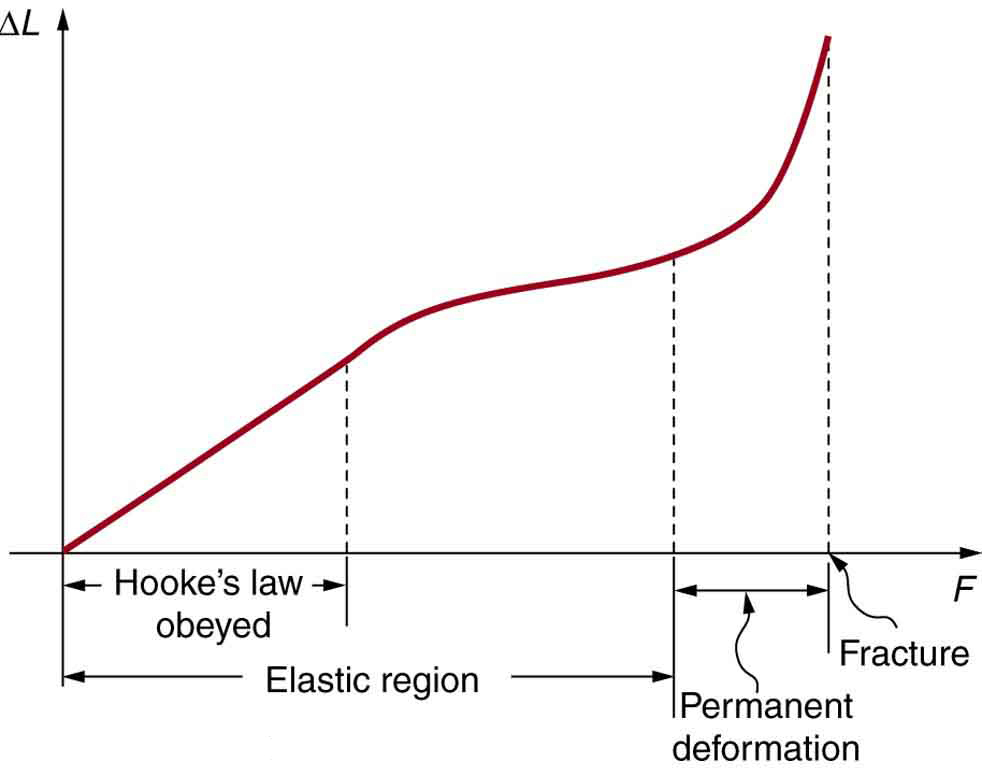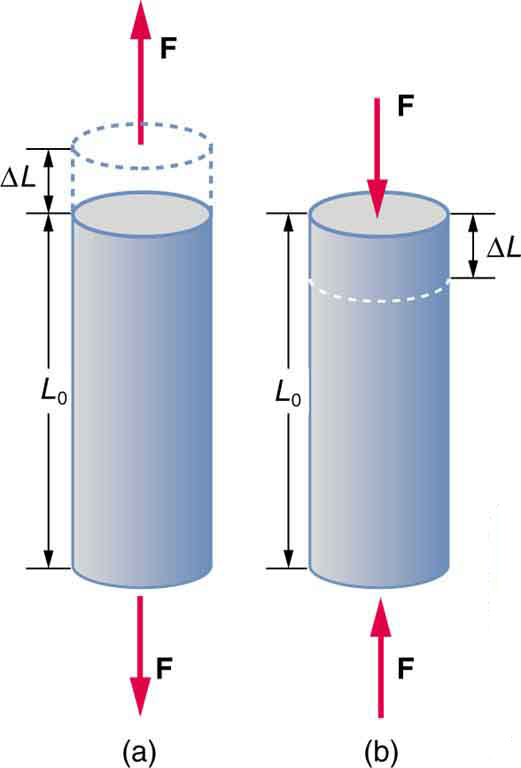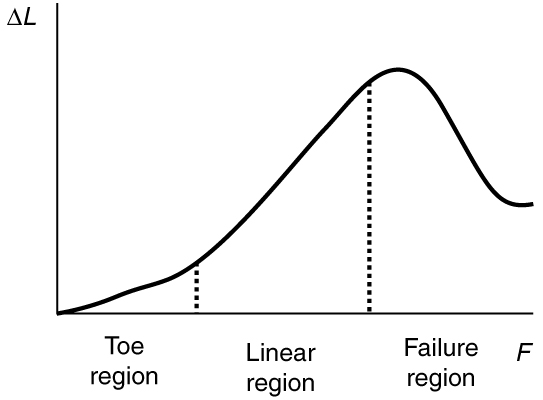71 10.1 Force-Deformation Curve
Forces can affect an object’s shape. A change in shape due to the application of a force is a deformation. Even very small forces are known to cause some deformation. For small deformations, two important characteristics are observed. First, the object returns to its original shape when the force is removed—that is, the deformation is elastic for small deformations. Second, the size of the deformation is proportional to the force—that is, for small deformations, Hooke’s law is obeyed. In equation form, Hooke’s law is given by
where ΔL is the amount of deformation (the change in length, for example) produced by the force F, and k is a proportionality constant that depends on the shape and composition of the object and the direction of the force. Note that this force is a function of the deformation ΔL — it is not constant as a kinetic friction force is. Sometimes we use Δx instead of ΔL. The deformation can be along any axis. Rearranging this to
makes it clear that the deformation is proportional to the applied force. Figure 1 shows the Hooke’s law relationship between the extension ΔL of a spring or of a human bone. For metals or springs, the straight line region in which Hooke’s law pertains is much larger. Bones are brittle and the elastic region is small and the fracture abrupt. Eventually a large enough stress to the material will cause it to break or fracture. Tensile strength is the breaking stress that will cause permanent deformation or fracture of a material.
HOOKE’S LAW
where ΔL is the amount of deformation (the change in length, for example) produced by the force F, and k is a proportionality constant that depends on the shape and composition of the object and the direction of the force.

The proportionality constant k depends upon a number of factors for the material.
We now consider the type of deformation that will cause a change in length (tension and compression). There are also sideways forces that cause shear (stress), and changes in volume, but we will not go into detail about them in this course.
Changes in Length—Tension and Compression: Elastic Modulus
A change in length ΔL is produced when a force is applied to a muscle or tendon parallel to its length L0, either stretching it (a tension) or compressing it. (See Figure 3.)

Experiments have shown that the change in length (ΔL) depends on only a few variables. As already noted, ΔL is proportional to the force F and depends on the substance from which the material is made. Additionally, the change in length is proportional to the original length L0 and inversely proportional to the cross-sectional area of the wire or rod. For example, a long guitar string will stretch more than a short one, and a thick string will stretch less than a thin one. We can combine all these factors into one equation for ΔL:
where ΔL is the change in length, F the applied force, Y is a factor, called the elastic modulus or Young’s modulus, that depends on the substance, A is the cross-sectional area, and L0 is the original length. Table 3 lists values of Y for several materials—those with a large Y are said to have a large tensile stiffness because they deform less for a given tension or compression.
Bones, on the whole, do not fracture due to tension or compression. Rather they generally fracture due to sideways impact or bending, resulting in the bone shearing or snapping. The behaviour of bones under tension and compression is important because it determines the load the bones can carry. Bones are classified as weight-bearing structures such as columns in buildings and trees. Weight-bearing structures have special features; columns in building have steel-reinforcing rods while trees and bones are fibrous. The bones in different parts of the body serve different structural functions and are prone to different stresses. Thus the bone in the top of the femur is arranged in thin sheets separated by marrow while in other places the bones can be cylindrical and filled with marrow or just solid. Overweight people have a tendency toward bone damage due to sustained compressions in bone joints and tendons.
Functionally, the tendon (the tissue connecting muscle to bone) must stretch easily at first when a force is applied, but offer a much greater restoring force for a greater strain. Figure 5 shows a stress-strain relationship for a human tendon. Some tendons have a high collagen content so there is relatively little strain, or length change; others, like support tendons (as in the leg) can change length up to 10%. Note that this stress-strain curve is nonlinear, since the slope of the line changes in different regions. In the first part of the stretch called the toe region, the fibers in the tendon begin to align in the direction of the stress—this is called uncrimping. In the linear region, the fibrils will be stretched, and in the failure region individual fibers begin to break. A simple model of this relationship can be illustrated by springs in parallel: different springs are activated at different lengths of stretch. Examples of this are given in the problems at end of this chapter. Ligaments (tissue connecting bone to bone) behave in a similar way.

Unlike bones and tendons, which need to be strong as well as elastic, the arteries and lungs need to be very stretchable. The elastic properties of the arteries are essential for blood flow. The pressure in the arteries increases and arterial walls stretch when the blood is pumped out of the heart. When the aortic valve shuts, the pressure in the arteries drops and the arterial walls relax to maintain the blood flow. When you feel your pulse, you are feeling exactly this—the elastic behaviour of the arteries as the blood gushes through with each pump of the heart. If the arteries were rigid, you would not feel a pulse. The heart is also an organ with special elastic properties. The lungs expand with muscular effort when we breathe in but relax freely and elastically when we breathe out. Our skins are particularly elastic, especially for the young. A young person can go from 100 kg to 60 kg with no visible sag in their skins. The elasticity of all organs reduces with age. Gradual physiological aging through reduction in elasticity starts in the early 20s.
Example 2: Calculating Deformation: How Much Does Your Leg Shorten When You Stand on It?
Calculate the change in length of the upper leg bone (the femur) when a 70.0 kg man supports 62.0 kg of his mass on it, assuming the bone to be equivalent to a uniform rod that is 40.0 cm long and 2.00 cm in radius.
Strategy
The force is equal to the weight supported, or
and the cross-sectional area is πr2 = 1.257 × 10-3 m2. The equation [latex]\boldsymbol{\Delta{L} = \frac{1}{Y}\frac{F}{A}L_0}[/latex] can be used to find the change in length.
Solution
All quantities except ΔL are known. Note that the compression value for Young’s modulus for bone must be used here. Thus,
Discussion
This small change in length seems reasonable, consistent with our experience that bones are rigid. In fact, even the rather large forces encountered during strenuous physical activity do not compress or bend bones by large amounts. Although bone is rigid compared with fat or muscle, several of the substances listed in Table 3 have larger values of Young’s modulus Y. In other words, they are more rigid.
The equation for change in length is traditionally rearranged and written in the following form:
The ratio of force to area, [latex]\boldsymbol{\frac{F}{A}},[/latex] is defined as stress (measured in N/m2), and the ratio of the change in length to length,[latex]\boldsymbol{\frac{\Delta{L}}{L_0}},[/latex]is defined as strain (a unitless quantity). In other words,
In this form, the equation is analogous to Hooke’s law, with stress analogous to force and strain analogous to deformation. If we again rearrange this equation to the form
we see that it is the same as Hooke’s law with a proportionality constant
This general idea—that force and the deformation it causes are proportional for small deformations—applies to changes in length, sideways bending, and changes in volume.
STRESS
The ratio of force to area, [latex]\boldsymbol{\frac{F}{A}},[/latex] is defined as stress measured in N/m2.
STRAIN
The ratio of the change in length to length, [latex]\boldsymbol{\frac{\Delta{L}}{L_0}},[/latex] is defined as strain (a unitless quantity). In other words,
Section Summary
- Hooke’s law is given by
[latex]\boldsymbol{F=k\Delta{L}},[/latex] or [latex]\boldsymbol{F=k\Delta{x}},[/latex]
where ΔL is the amount of deformation (the change in length), F is the applied force, and k is a proportionality constant that depends on the shape and composition of the object and the direction of the force. The relationship between the deformation and the applied force can also be written as
[latex]\boldsymbol{\Delta{L}\:=}\boldsymbol{\frac{1}{Y}\frac{F}{A}}\boldsymbol{L_0},[/latex]where Y is Young’s modulus, which depends on the substance, A is the cross-sectional area, and L0 is the original length.
- The ratio of force to area, [latex]\boldsymbol{\frac{F}{A}},[/latex] is defined as stress, measured in N/m2.
- The ratio of the change in length to length, [latex]\boldsymbol{\frac{\Delta{L}}{L_0}},[/latex] is defined as strain (a unitless quantity). In other words,
[latex]\boldsymbol{\textbf{stress}=Y\times\textbf{strain}}.[/latex]
Conceptual Questions
1: The elastic properties of the arteries are essential for blood flow. Explain the importance of this in terms of the characteristics of the flow of blood (pulsating or continuous).
2: What are you feeling when you feel your pulse? Measure your pulse rate for 10 s and for 1 min. Is there a factor of 6 difference?
3: Examine different types of shoes, including sports shoes and thongs. In terms of physics, why are the bottom surfaces designed as they are? What differences will dry and wet conditions make for these surfaces?
4: Would you expect your height to be different depending upon the time of day? Why or why not?
5: Why can a squirrel jump from a tree branch to the ground and run away undamaged, while a human could break a bone in such a fall?
Problems & Exercises
1: During a circus act, one performer swings upside down hanging from a trapeze holding another, also upside-down, performer by the legs. If the upward force on the lower performer is three times her weight, how much do the bones (the femurs) in her upper legs stretch? You may assume each is equivalent to a uniform rod 35.0 cm long and 1.80 cm in radius. Her mass is 60.0 kg.
2: During a wrestling match, a 150 kg wrestler briefly stands on one hand during a maneuver designed to perplex his already moribund adversary. By how much does the upper arm bone shorten in length? The bone can be represented by a uniform rod 38.0 cm in length and 2.10 cm in radius.
3: (a) By how much does a 65.0-kg mountain climber stretch her 0.800-cm diameter nylon rope when she hangs 35.0 m below a rock outcropping? (b) Does the answer seem to be consistent with what you have observed for nylon ropes? Would it make sense if the rope were actually a bungee cord?
Footnotes
- 1 Approximate and average values. Young’s moduli Y for tension and compression sometimes differ but are averaged here. Bone has significantly different Young’s moduli for tension and compression.
Glossary
- deformation
- change in shape due to the application of force
- Hooke’s law
- proportional relationship between the force F on a material and the deformation ΔL it causes, F = kΔL
- tensile strength
- the breaking stress that will cause permanent deformation or fraction of a material
- stress
- ratio of force to area
- strain
- ratio of change in length to original length
- shear deformation
- deformation perpendicular to the original length of an object
Solutions
Problems & Exercises
1: [latex]\boldsymbol{1.90\times10^{-3}\textbf{ cm}}[/latex]
3: (a) $\boldsymbol{9\textbf{ cm}}$ (b) This seems reasonable for nylon climbing rope, since it is not supposed to stretch that much.

